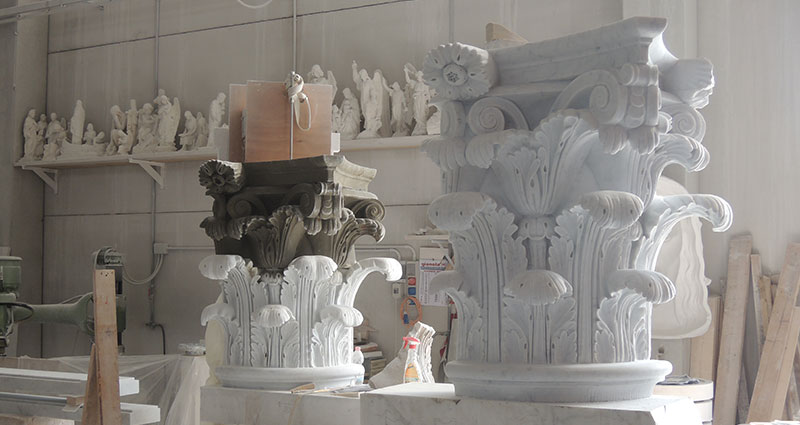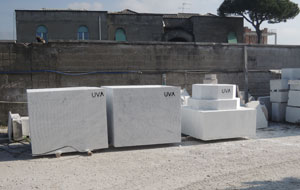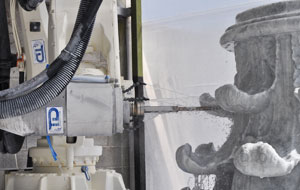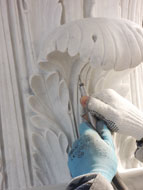Blocks of Italian marble transformed into Jefferson’s original vision

By Jane DeGeorge
UVA Facilities Management
(434)982-5846
jad2tm@virginia.edu
The ongoing installation of the Rotunda’s new marble capitals marks the end of their long journey from the mountains of Carrara, Italy. The capitals started out as 9,000-pound square blocks carved from the Campanili Quarry. These blocks were etched with the letters “UVA” and trucked down winding roads and hairpin turns to the nearby Pedrini Sculptors Studio.
Twenty-four hours a day and seven days a week over a month’s time, a robotic CNC machine carved the blocks down to within a quarter of an inch of their finished surface and their final weight of 6,300 pounds. Each capital was then finished by hand, with the sculptors etching their signatures onto the top of each piece.
“This [hand-finishing] process produces nuanced differences between each capital, replicating the fine craftsmanship executed on the originals,” according to Capital Construction & Renovations Project Manager James Zehmer, who is acting as the assistant project manager for the Rotunda renovation project.



The capital installation process — a significant milestone in the project — was kicked off last week by University of Virginia President Teresa Sullivan and project team members from Capital Construction & Renovations and the Office of the Architect.
“The Rotunda is truly the iconic building of the University,” Sullivan said as she stood between a bright white, newly completed capital and a discolored, deteriorating capital that was removed from the Rotunda in January. “It is important for us to take good care of it.”
The renovation project — which is expected to be complete in July 2016 — is led by CC&R staff, Supervisory Historic Preservation Architect Jody Lahendro, Supervisory Senior Construction Administration Manager Steve Ratliff, Project Coordinator Sarita Herman and Zehmer, in conjunction with UVA Office of the Architect Senior Historic Preservation Planner Brian Hogg and Architectural Conservator Mark Kutney. The project architect is the firm of John G. Waite and Associates; The Whiting-Turner Contracting Company is performing well as the construction management firm, and Berkel Contractors, Rugo Stone and Pedrini Sculptors are key sub-contractors involved in the capital replacement process.
The severe deterioration of the recently replaced capitals was first identified five years ago when a pile of what appeared to be sand was discovered on the Rotunda’s portico, according to Lahendro. A few weeks later, another pile was discovered. Upon greater inspection, it became clear that the capitals were crumbling. This process is called “sugaring,” according to Hogg, who demonstrated the deterioration by rubbing an old capital fragment in his hand until it turned into particles as fine as sugar and sand. To prevent pieces from falling off, the old capitals were covered in black debris netting in 2010.
The fire of 1895 heavily damaged the Rotunda’s original capitals, which were made from Carrara marble and installed in 1826. The replacements were made of domestic marble and carved in place years after their installation once adequate funds were secured. Over the years, these replacements have suffered from various environmental conditions while other surviving Jefferson-period Carrara marble capitals located at Pavilions II, III, V and VIII are still in good condition today.
The creation of the new capitals has been a complex process spanning over the past year and a half. Project team members worked hard to replicate the design of Jefferson’s originals by closely studying historic photographs of the Rotunda, according to Zehmer. One detail that stood out in an image from 1892 is the negative space within the scroll motif, known as a volute, on the corner of each capital. This detail — which allows light to pass through part of the capital — was not present in the capitals that were installed during the post-fire renovation, but has been successfully incorporated into the newly completed ones.
The team also inspected the fragments of the remaining Jeffersonian Rotunda capitals, the largest of which is located in front of the Fralin Museum of Art. These fragments were scanned with a laser to create three-dimensional digital images to assist in the replication.
During the carving process, UVA project team members reviewed three stages of mock-ups making suggested revisions as needed to ensure every detail matched the intended design. The third mock-up — a full-size capital made completely of marble — was used as the model for the remaining 15.
Master Carver Umberto Puccetti oversaw two teams of four craftsmen and craftswomen who worked to finish each capital by hand, a careful process that takes three weeks per capital. “There were a lot of different hands on them,” Zehmer said of the capitals. “So they are all slightly different, which is the desired effect — the original capitals were carved by hand and had subtle differences between them. We want to replicate that aspect of the carving process as well.” Hogg captured it best by saying, “We want the capitals to all be brothers, but they don’t all need to be twins.”
As the capitals are completed, they are shipped to Charlottesville in batches, going through customs in Norfolk before their final arrival on Grounds. Workers from Rugo Stone started installing a few of the newly completed capitals last week on the south side of the Rotunda.
During this process, a structural steel shoring system supports the south portico roof. A large crane lifts each capital onto the shoring structure and into a custom-made wheeled cart that Rugo Stone workers roll into place above each column. Following the installation of all 10 capitals on the south side, the process will be repeated on the north portico for the replacement of the six capitals on that side later this year.
Jane DeGeorge
Communications Generalist
Human Resources & Training
UVA Facilities Management
(434)982-5846
jad2tm@virginia.edu
Photos by James Zehmer, UVA Facilities Management